Abstract
Horizontal and vertical eye movements of ten human subjects were recorded with a scleral induction-coil technique during voluntary pursuit of sinusoidal, triangular and pseudo-random target motions of different frequency, amplitude and dimensionality upon a dark, diffuse or structured background. Data processing included separation of the composite eye movement into a cumulative smooth and saccadic displacement, computation of gain and phase of the composite and smooth eye movements with respect to the target movement and analysis of retinal position error. Pursuit eye movements were never completely smooth. Smooth pursuit gain was always lower than 0.95 and saccades were used to supplement the smooth eye movements in pursuing the target with the proper amplitude. The gain of composite eye movements was about unity for sinusoidal target motions and ramps; it exceeded unity for the highest frequency components in a pseudo-random motion. The gain of the smooth eye movements decreased monotonously whenever target velocity increased. It was higher for single sine waves than for a pseudo-random motion, however, with pseudo-random motion it was relatively higher for the higher frequency components. Phase lags were in general smaller for single sine waves than for pseudo-random motion, but for the latter a phase lead of the smooth component was consistently found for the lower frequency components. During pursuit of a rhomboid trajectory, the eye movements showed directional errors which are interpreted as anticipatory behaviour. The distribution of the retinal error was symmetrical around zero. Its standard deviation varied between about 0.2 and 1.3 degrees; it was about proportional to target velocity and inversely proportional to smooth pursuit gain. It was limited by the insertion of saccades which were in general corrective. The influence of a diffusely illuminated background was minimal. A structured background inhibited smooth pursuit in the horizontal direction by about 10% and in the vertical direction by about 20%. This deficit of smooth pursuit was fully compensated by the insertion of more saccades and had no consequences for the standard deviation of the retinal error. The type of structure of the background was only of marginal importance. Horizontal pursuit was in general slightly smoother and more precise than vertical pursuit.
Full text
PDF
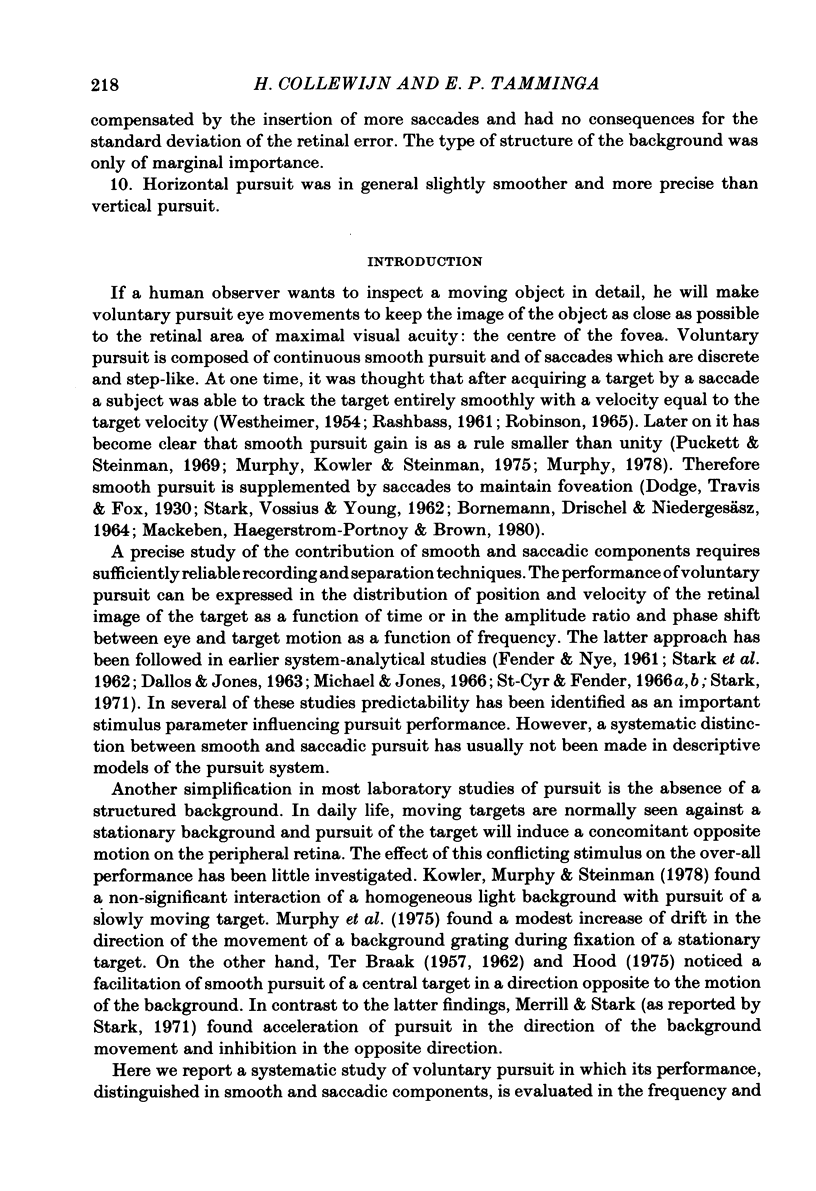

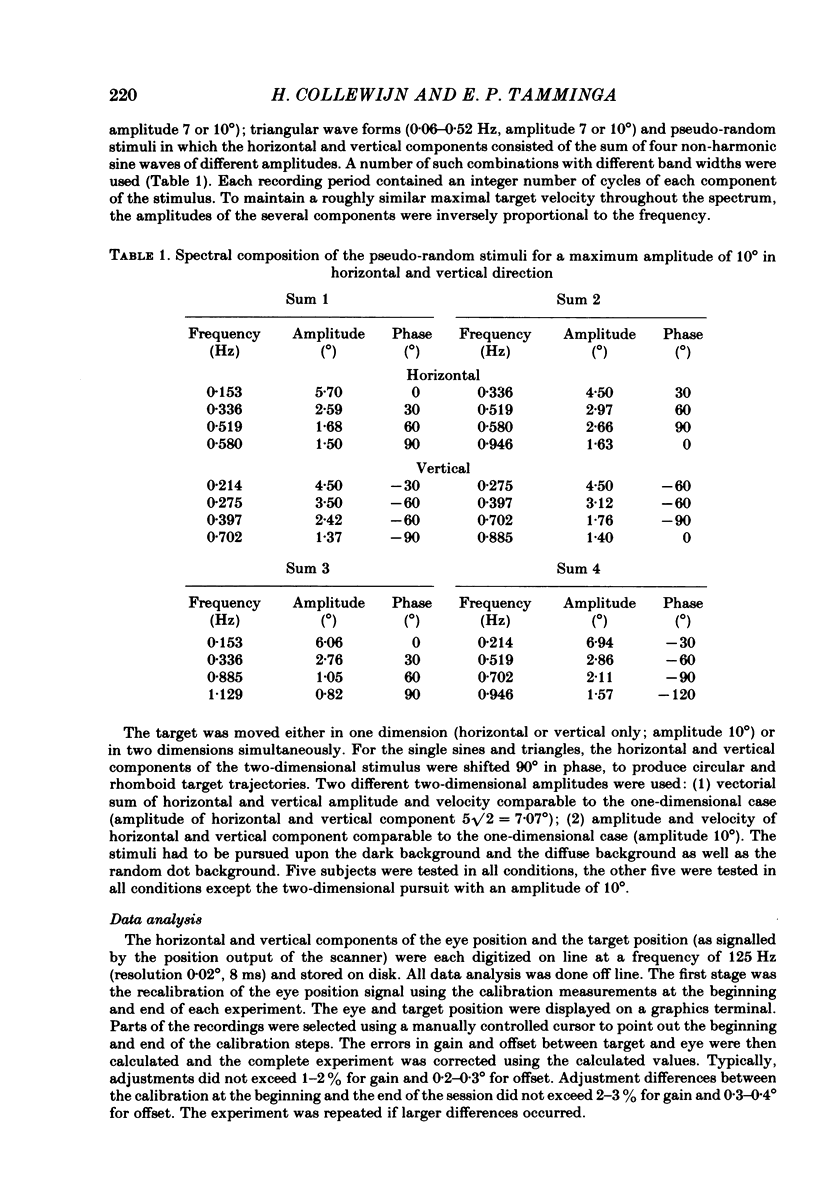
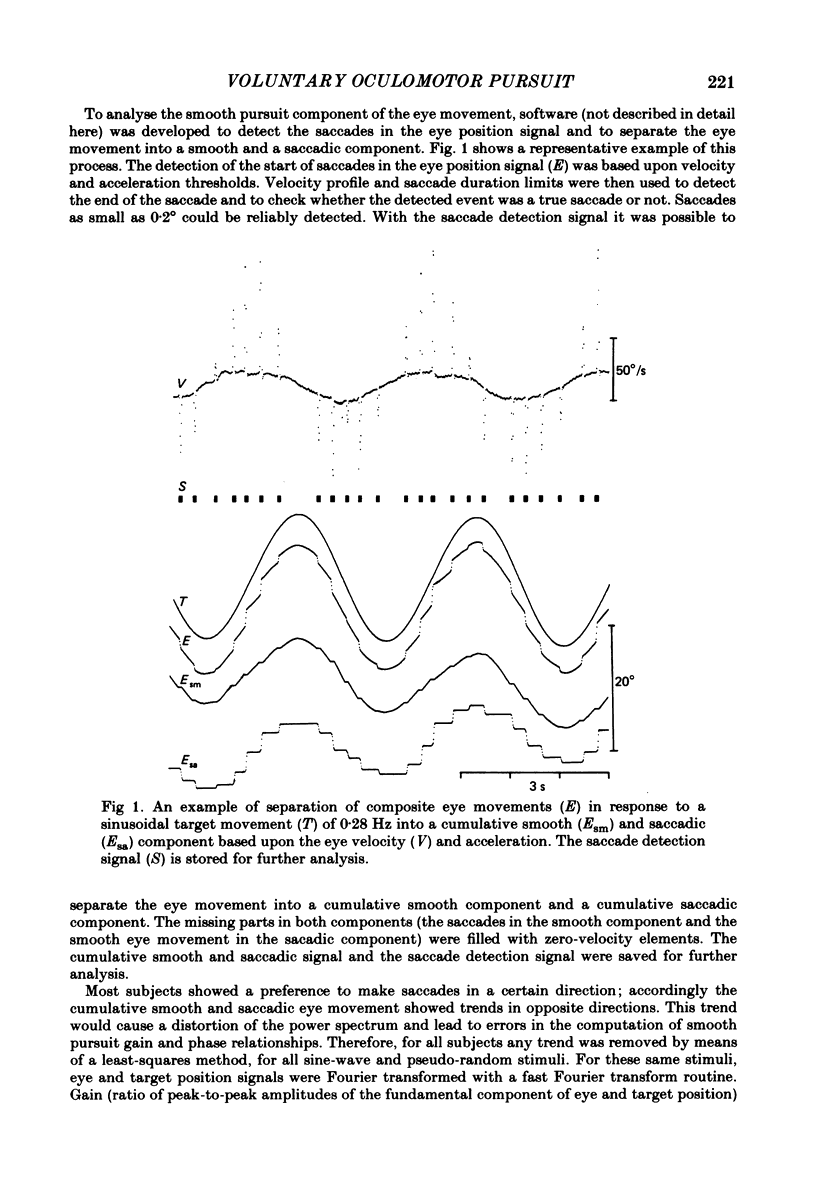
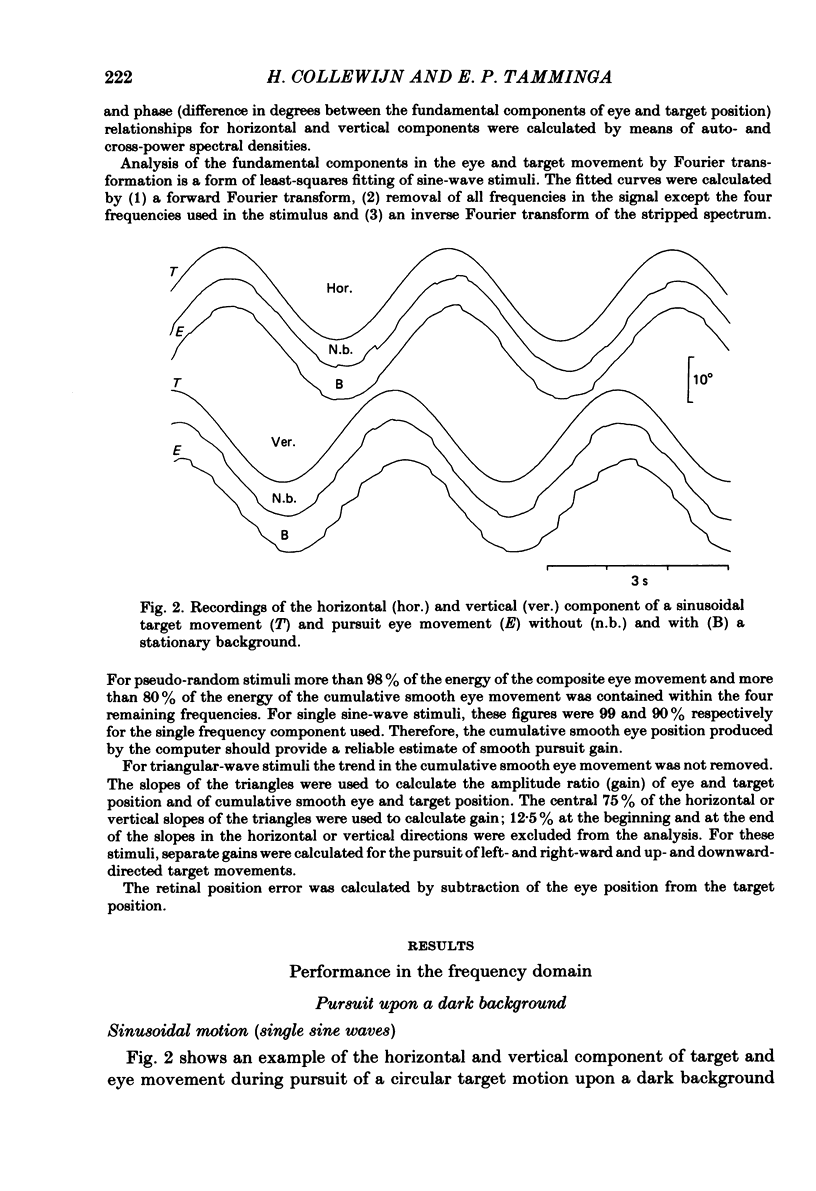
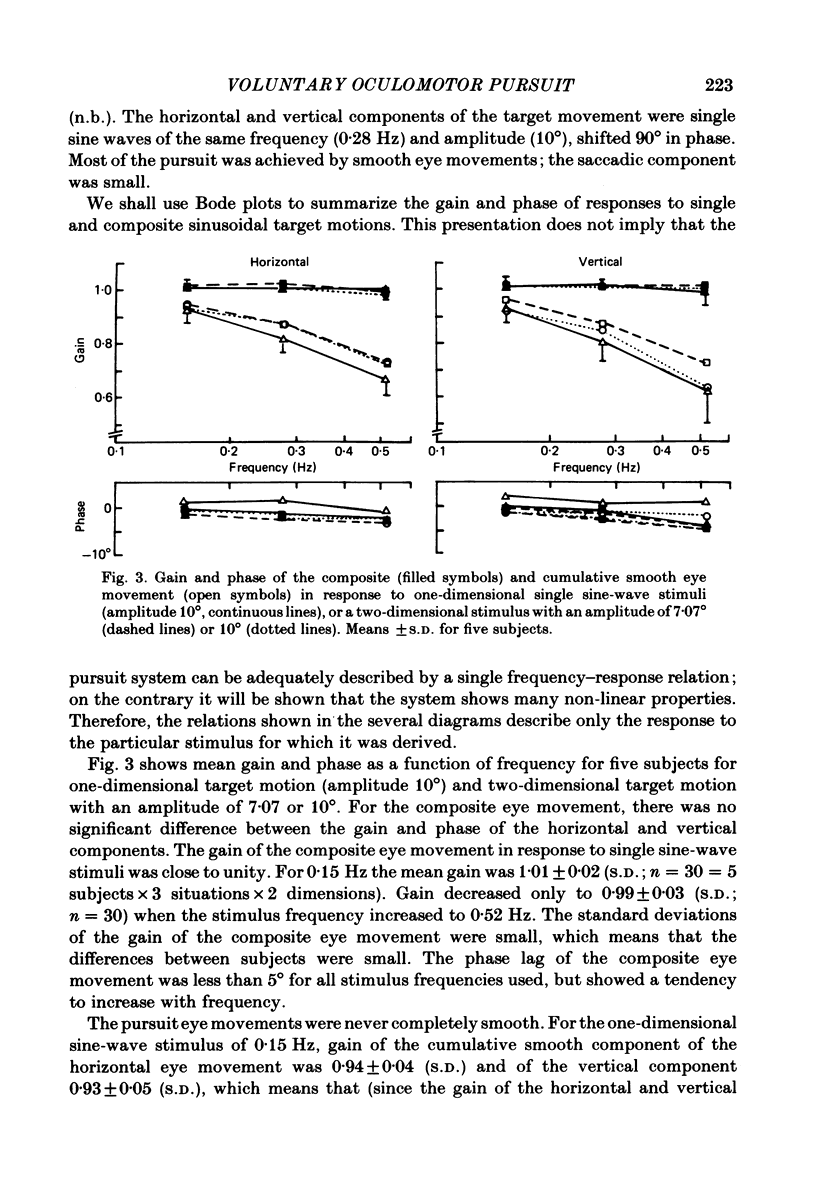
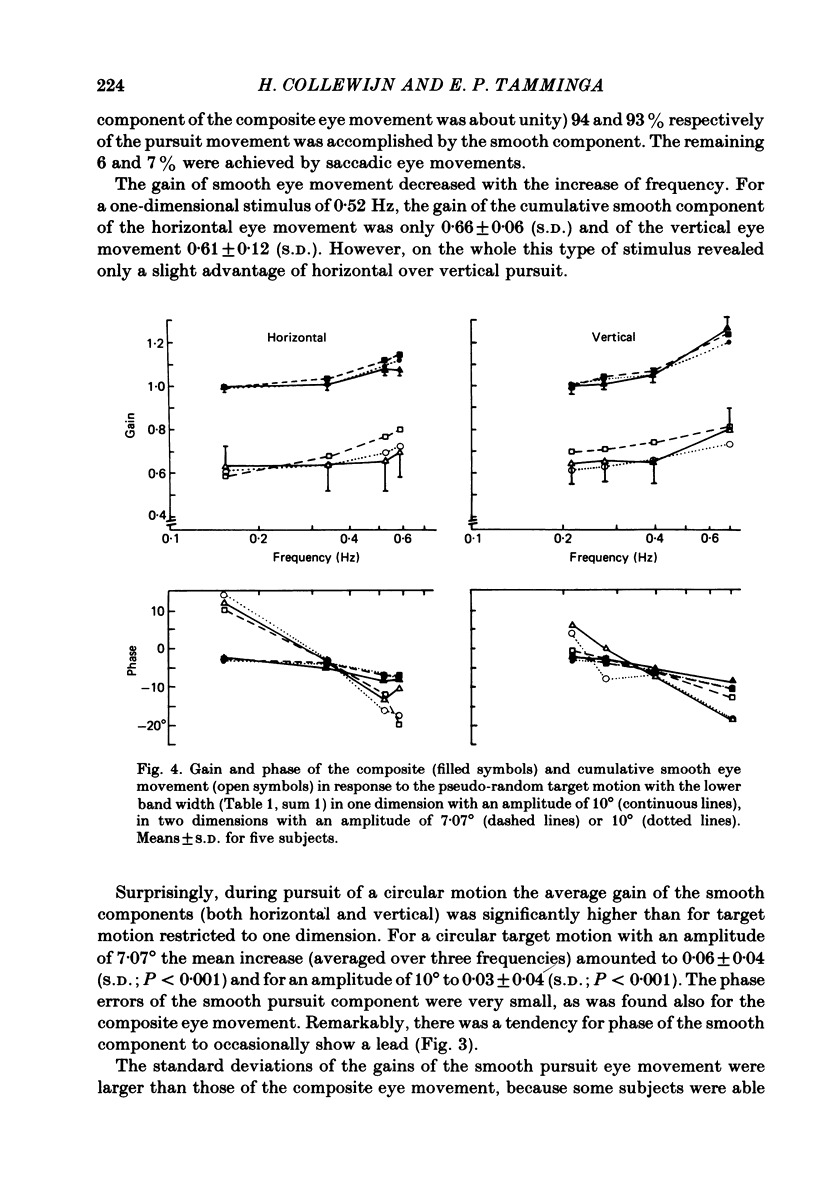
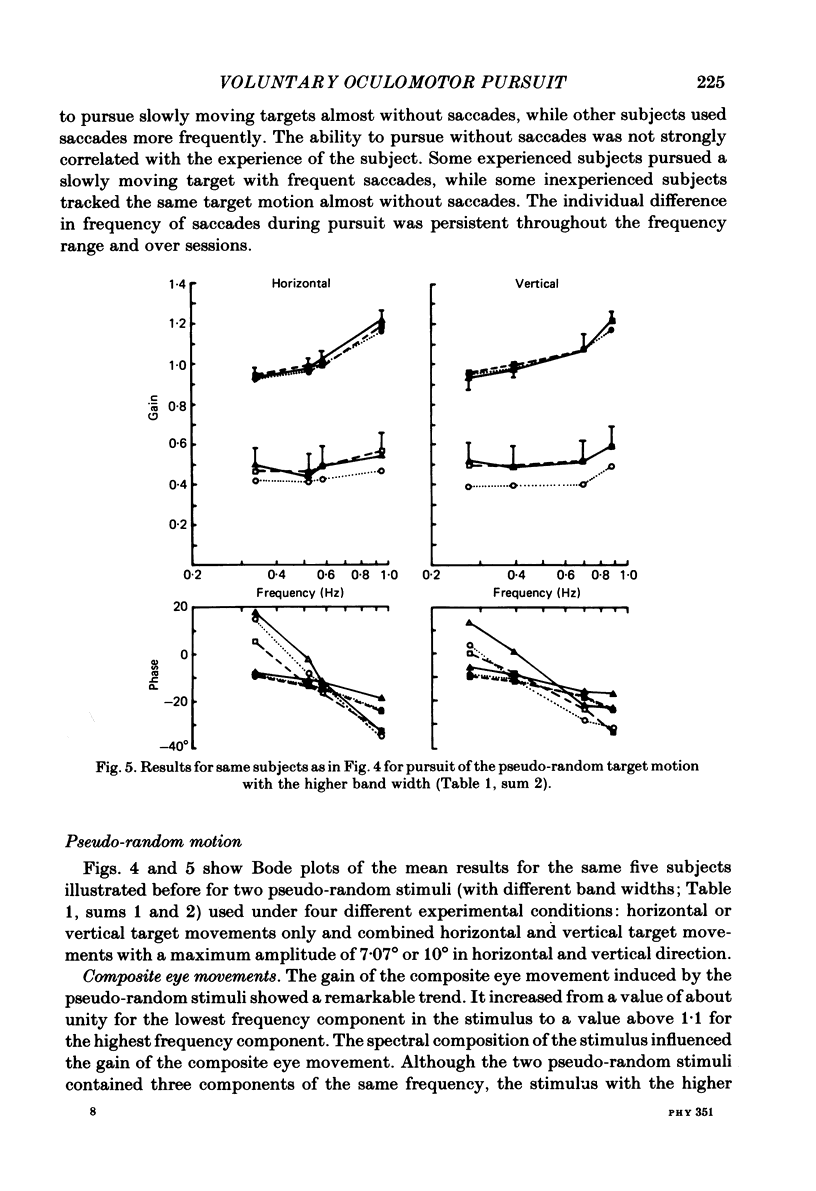
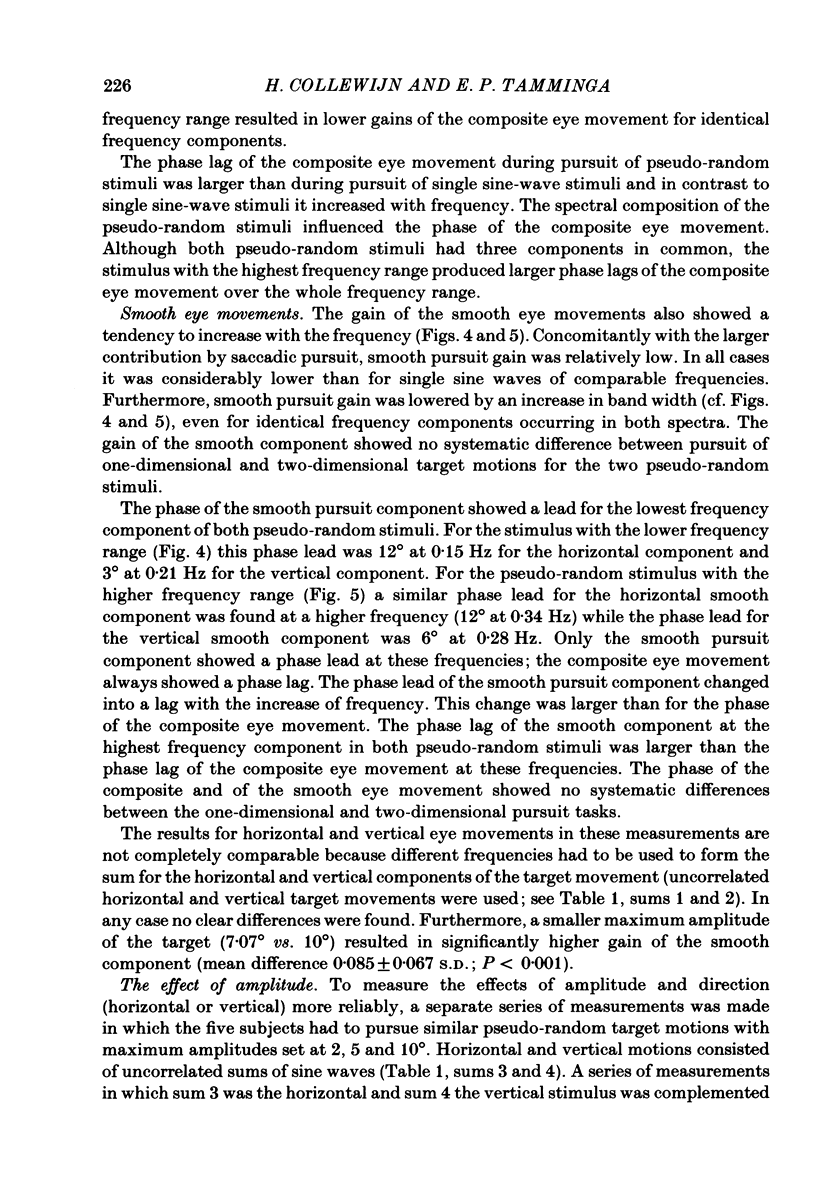
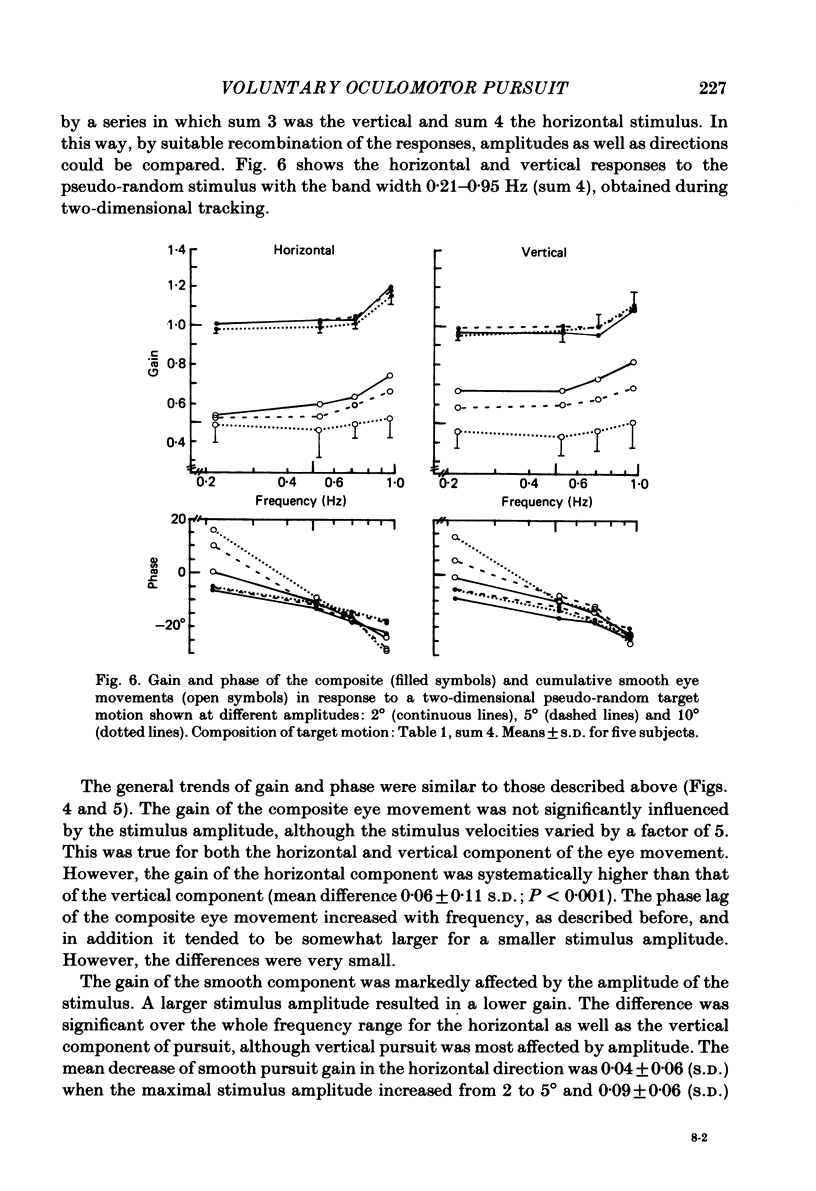
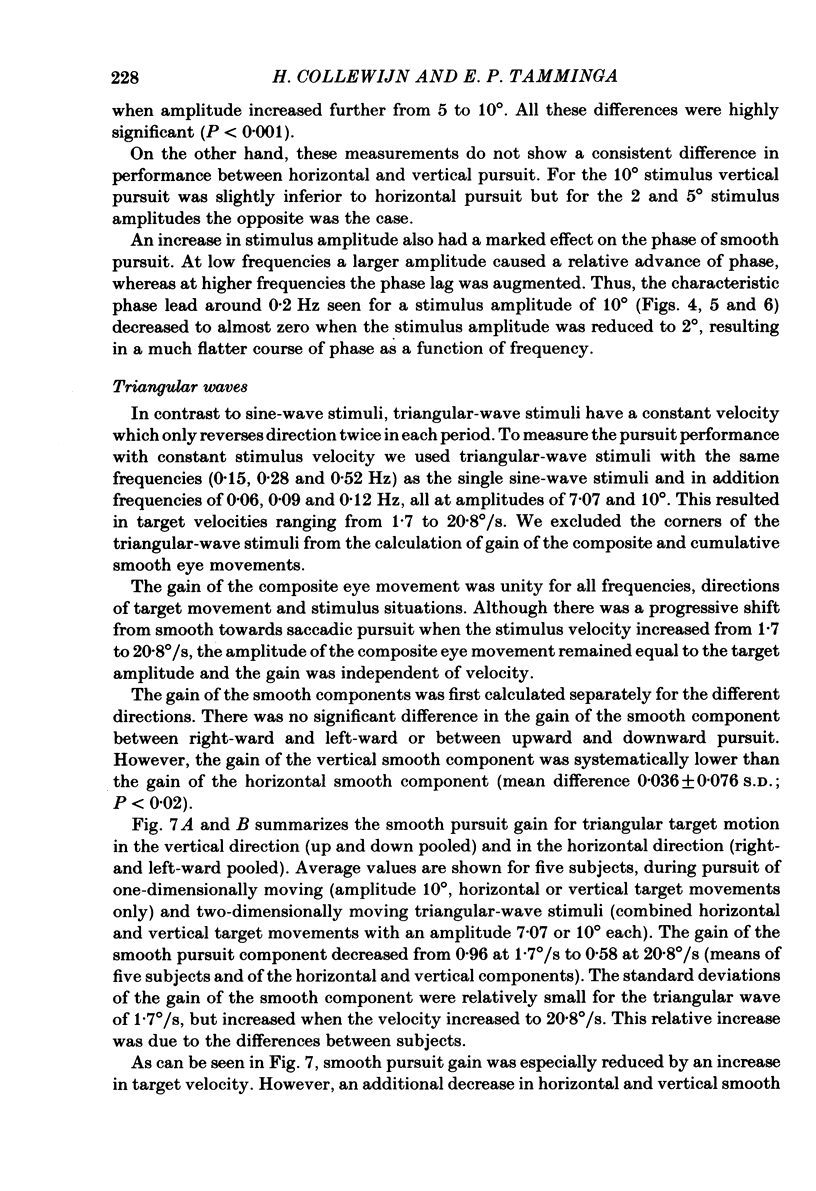
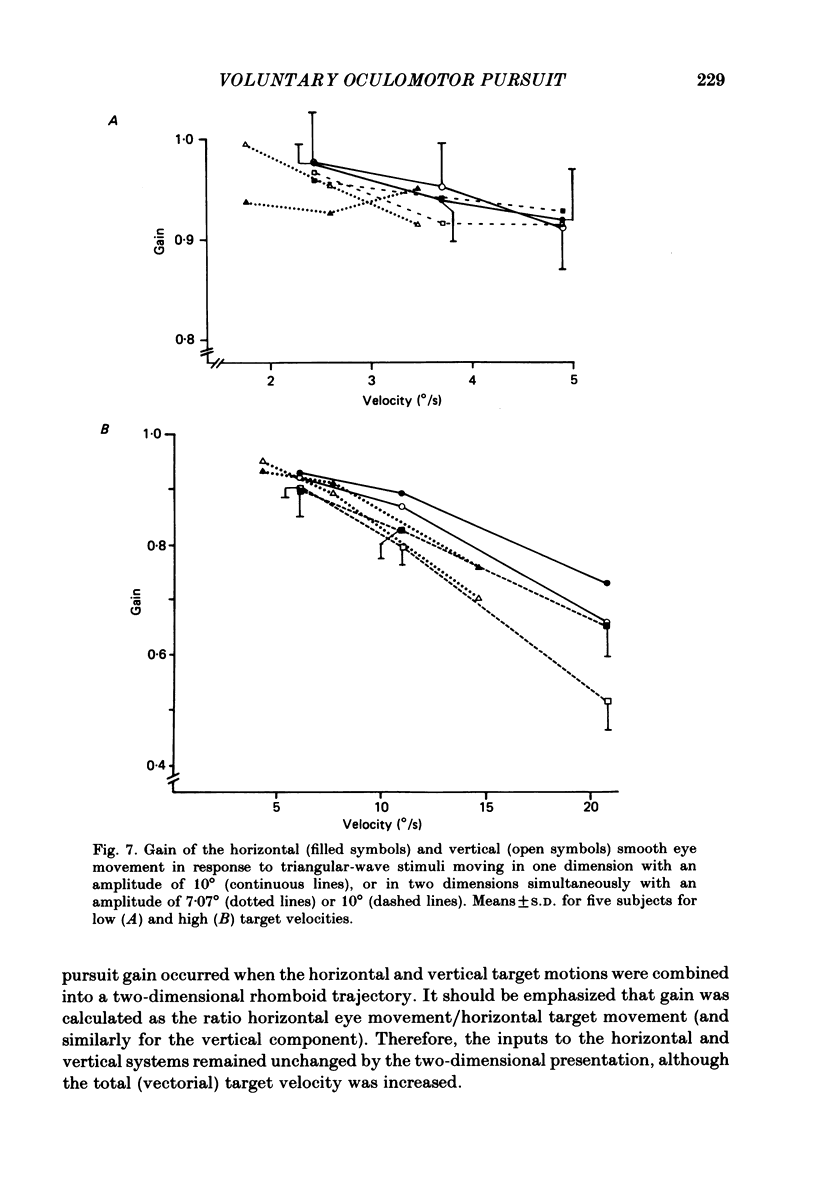
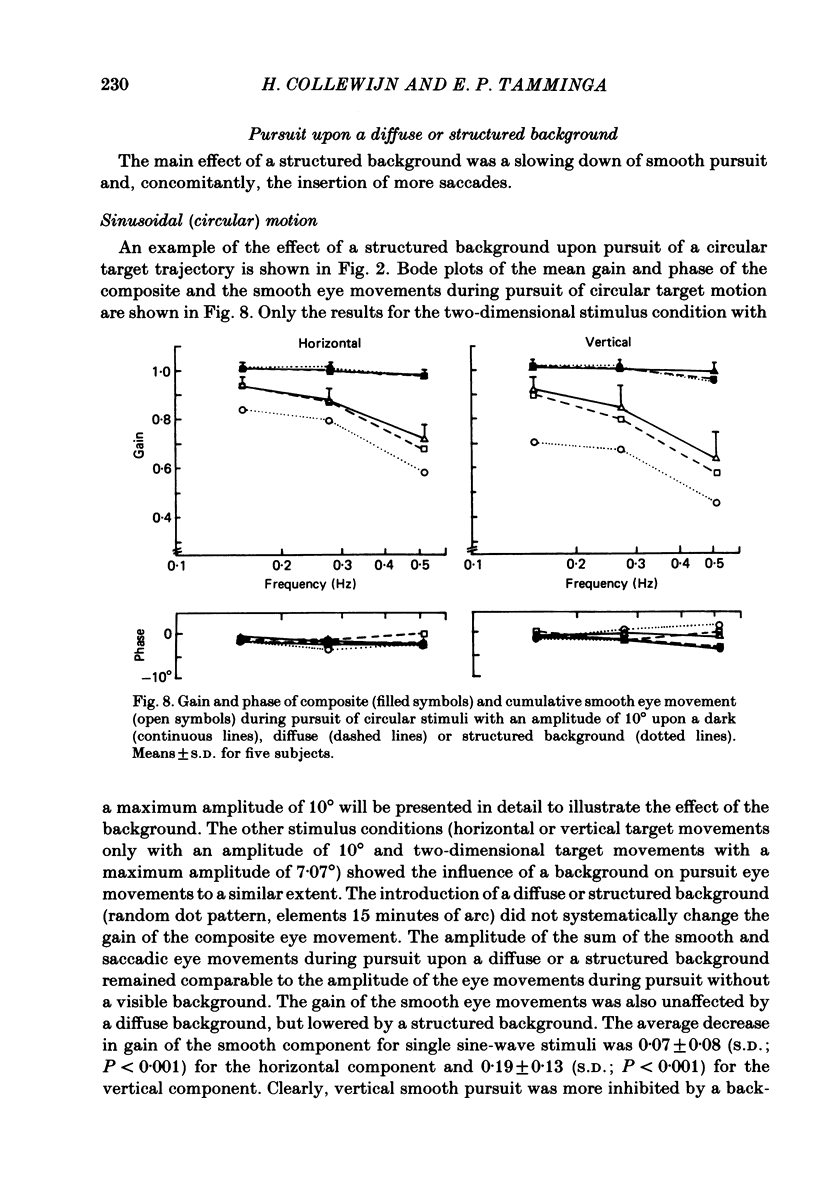
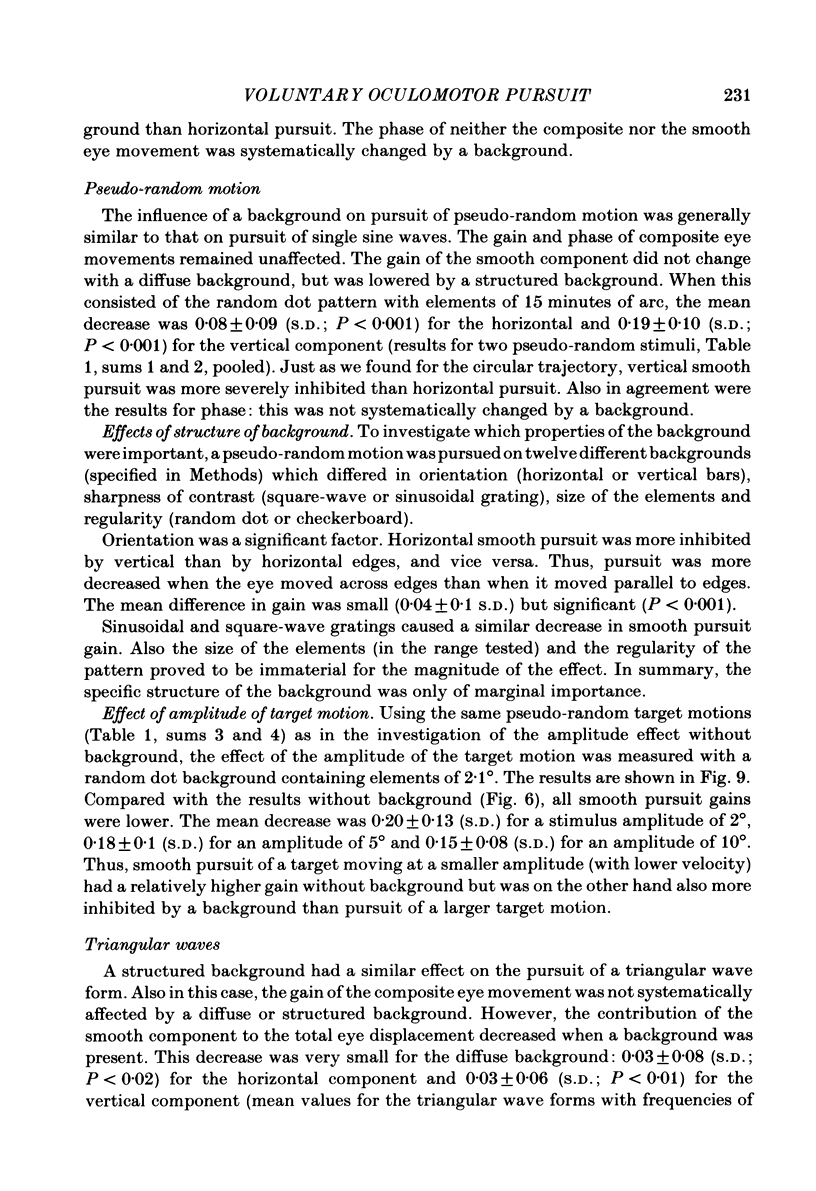
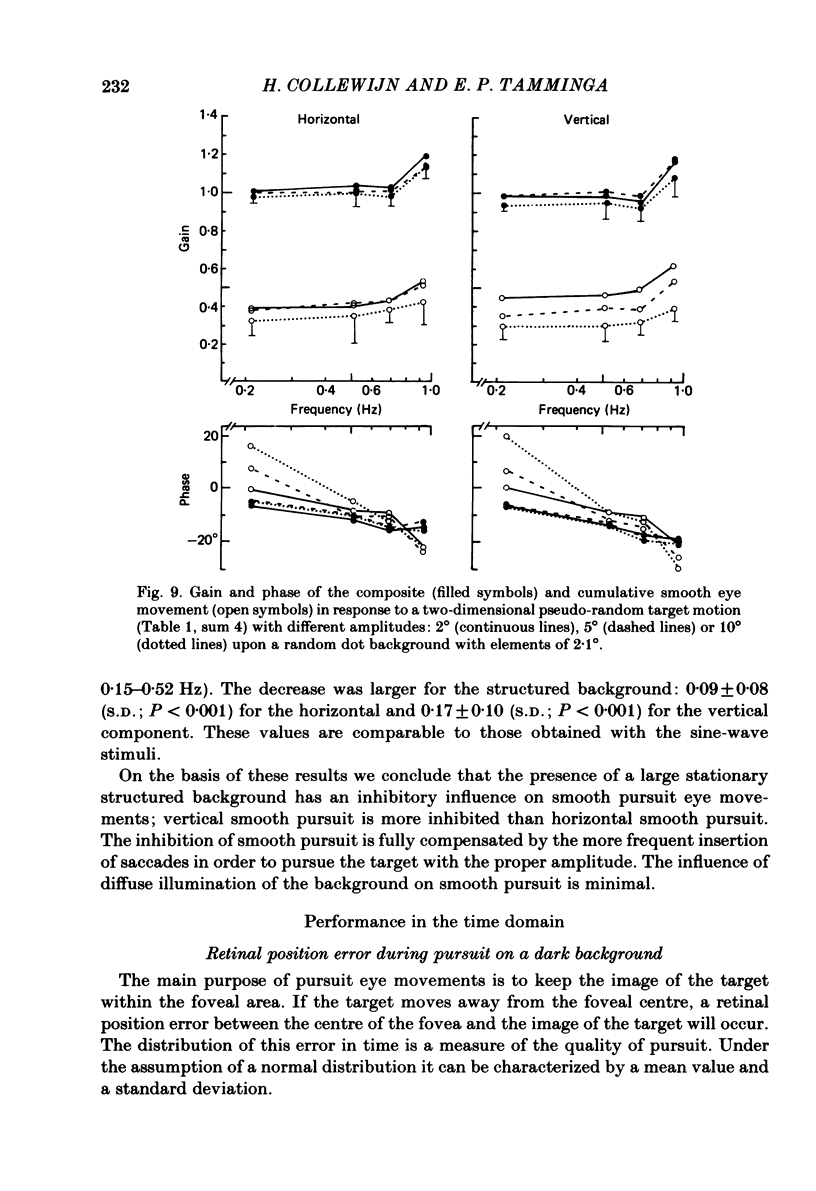
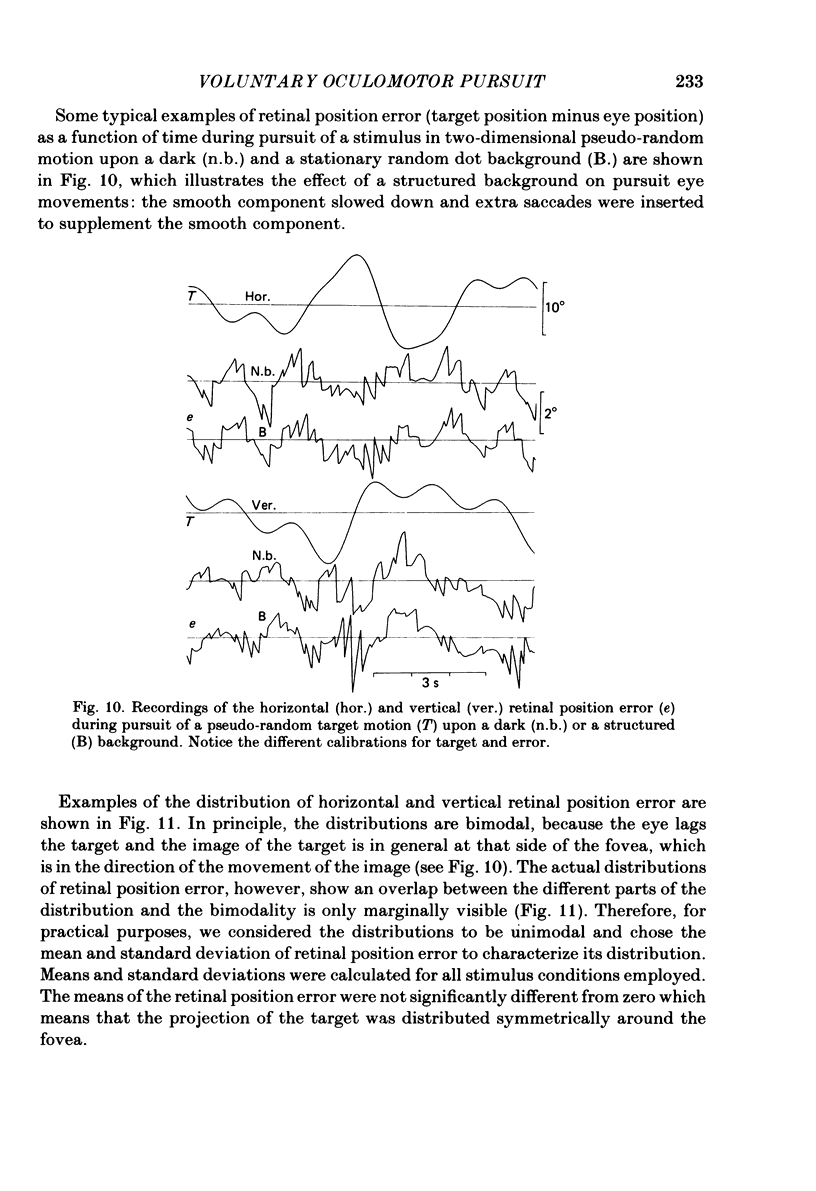
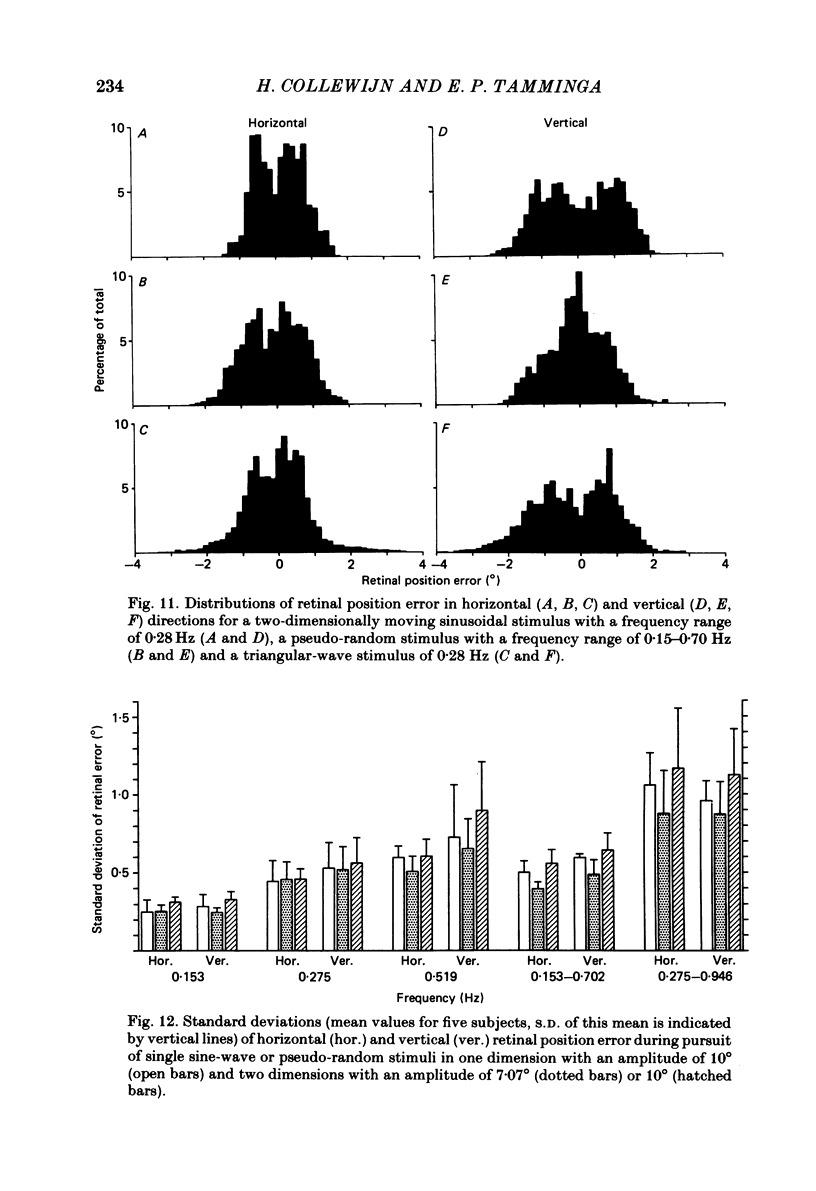
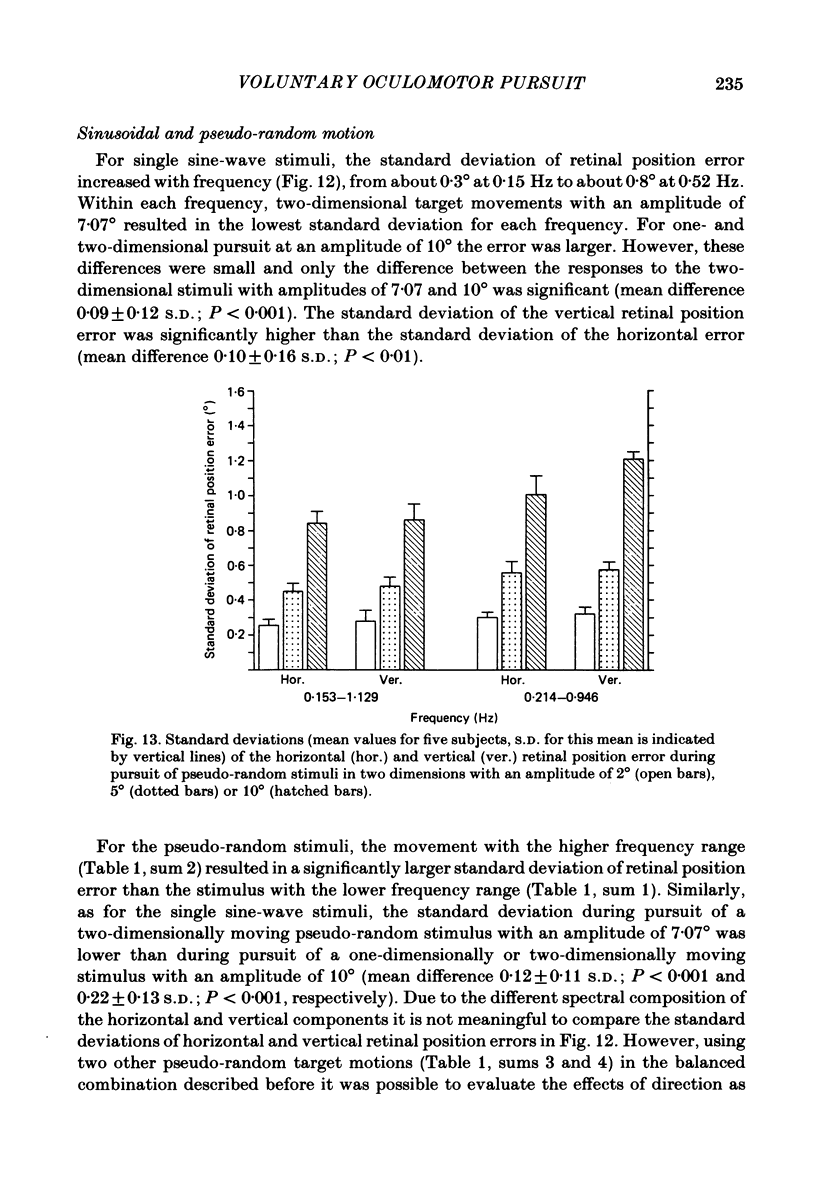
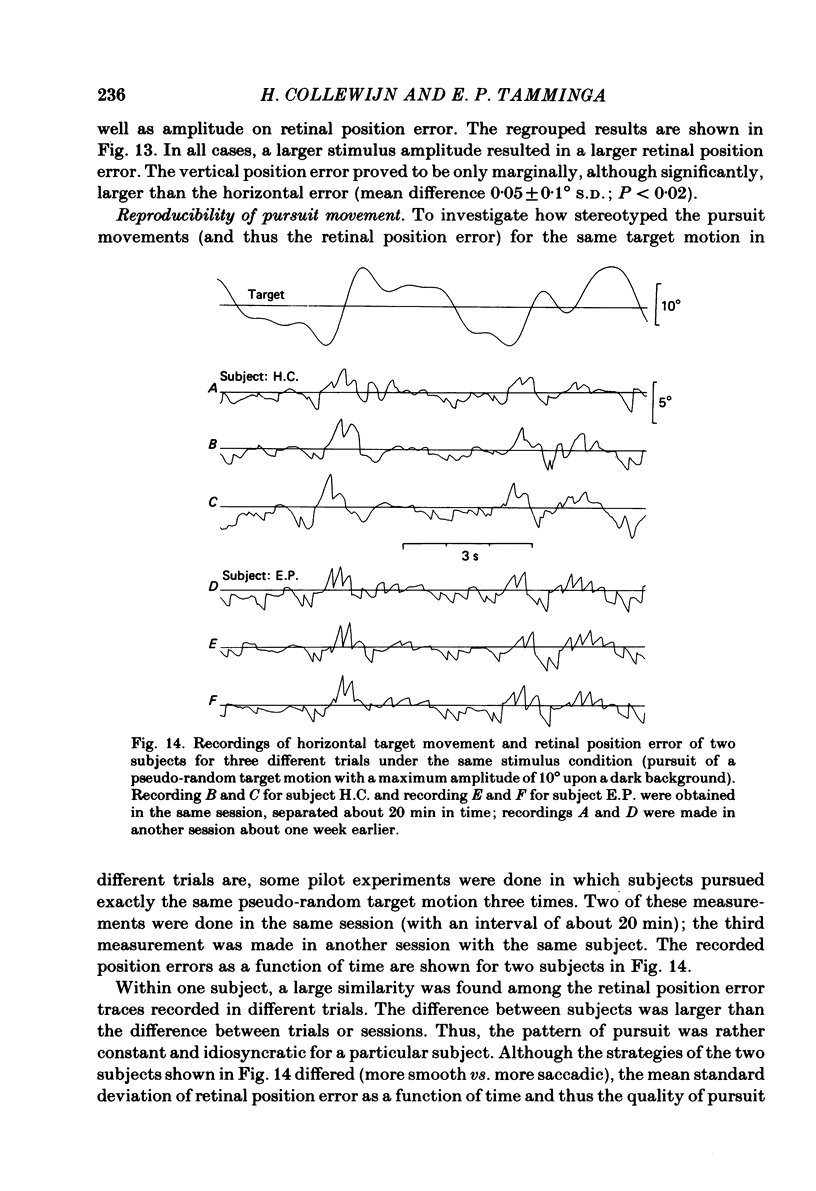
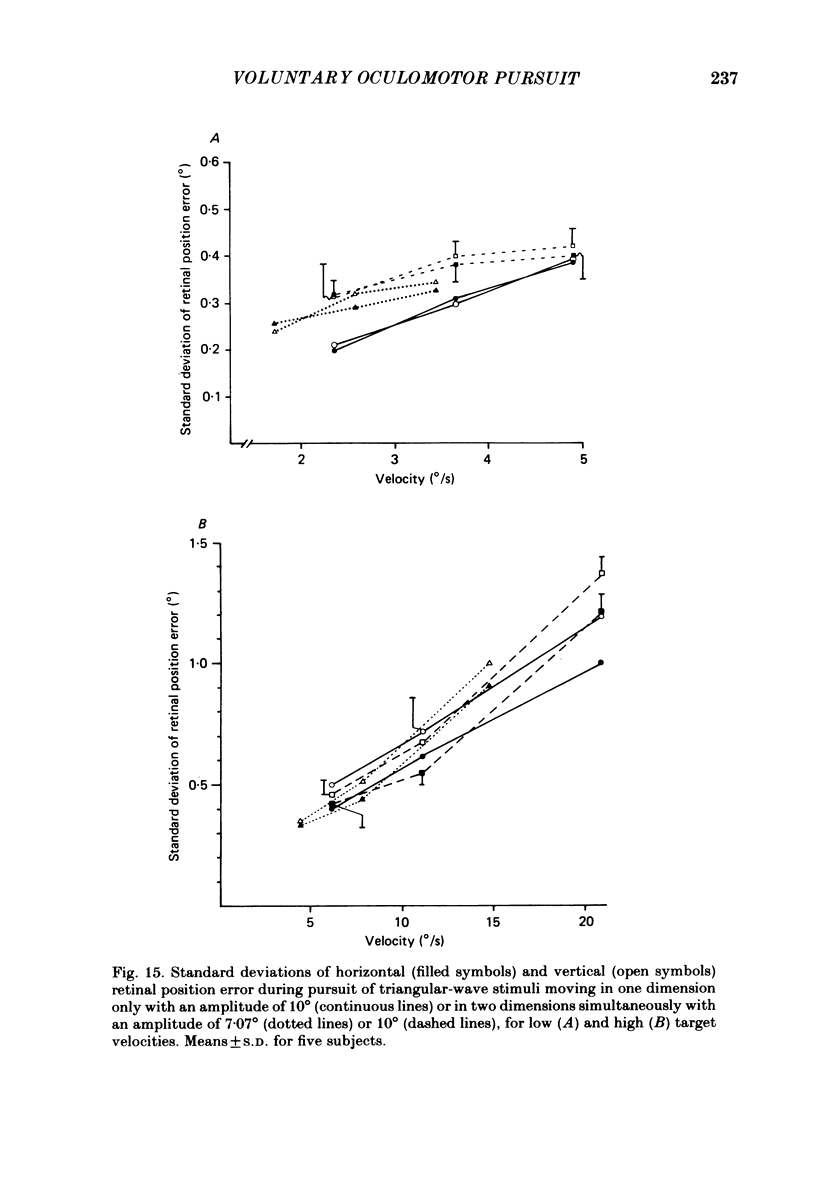


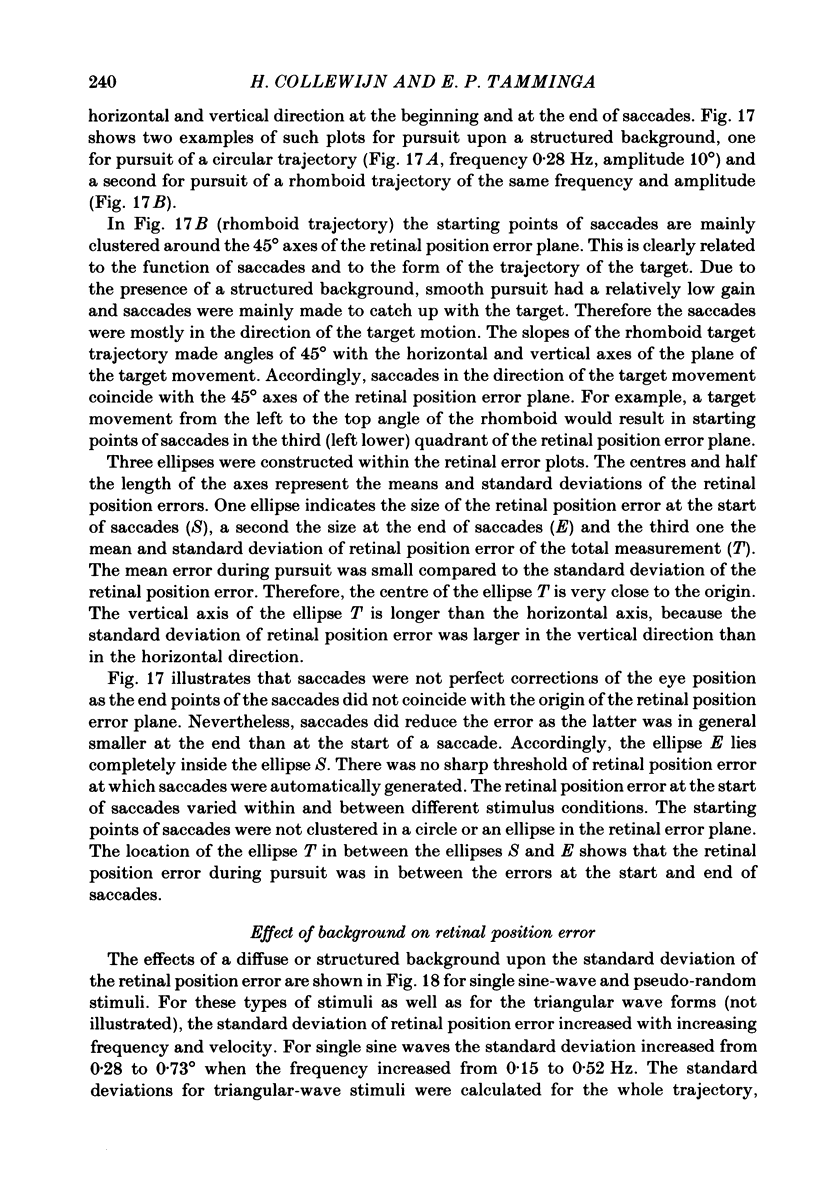
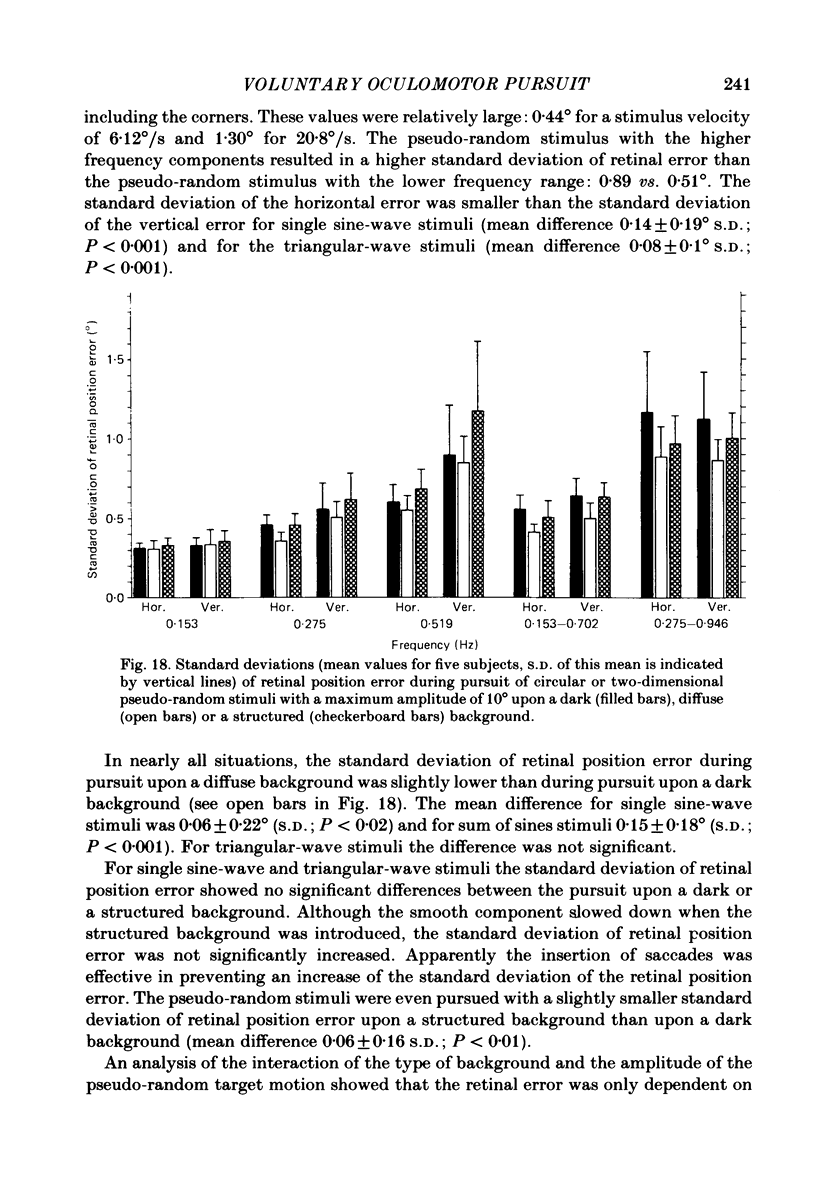

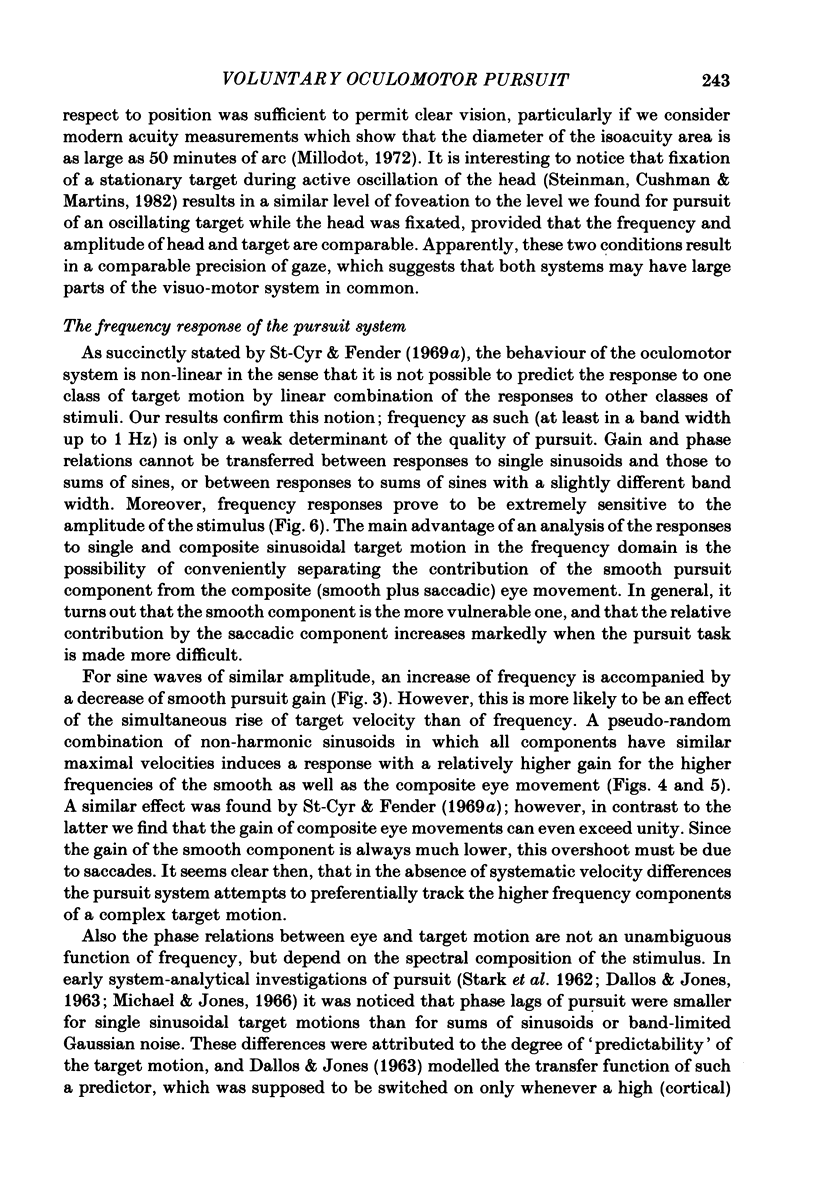
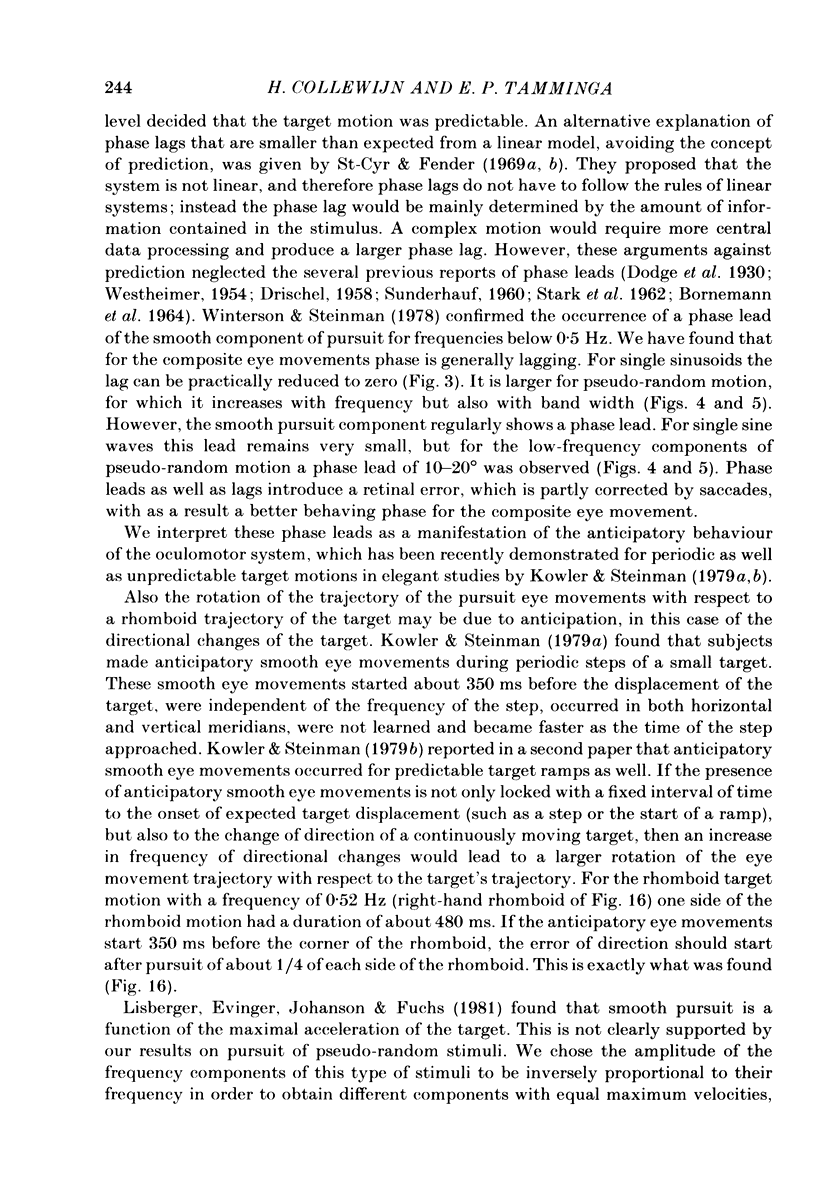
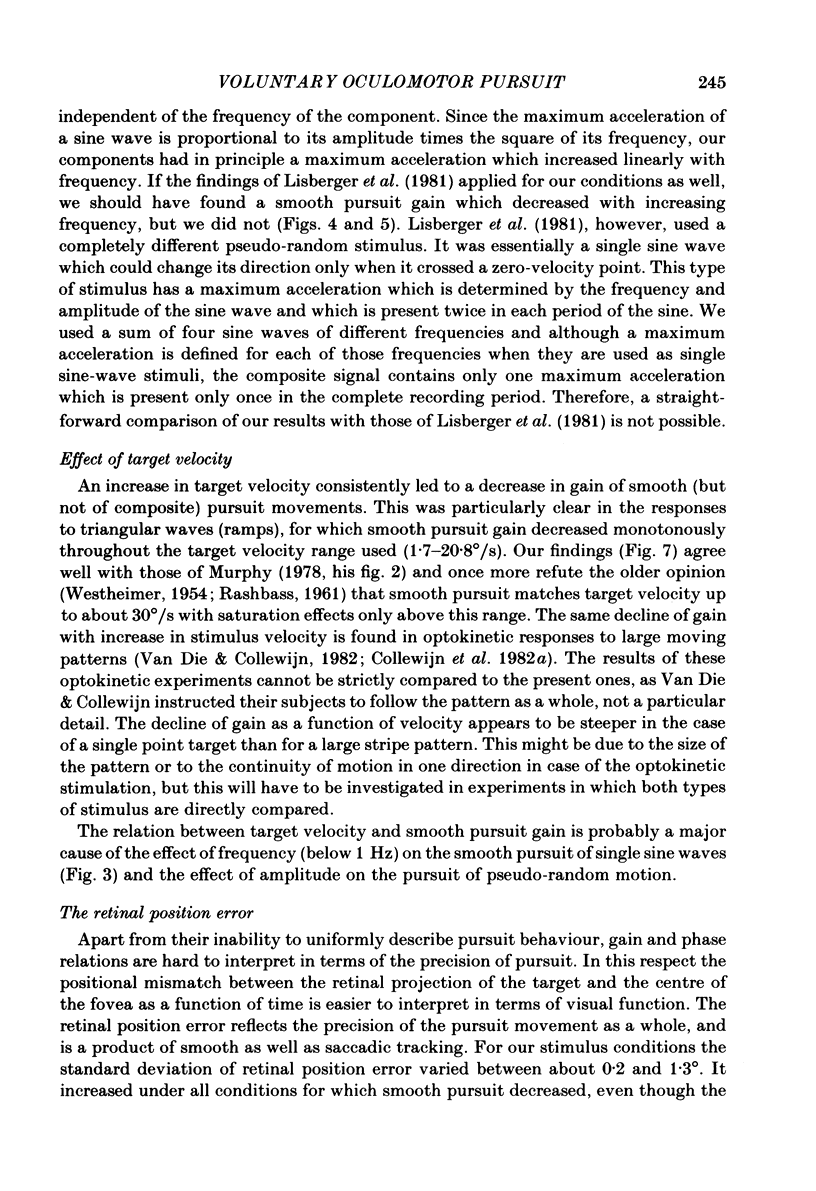

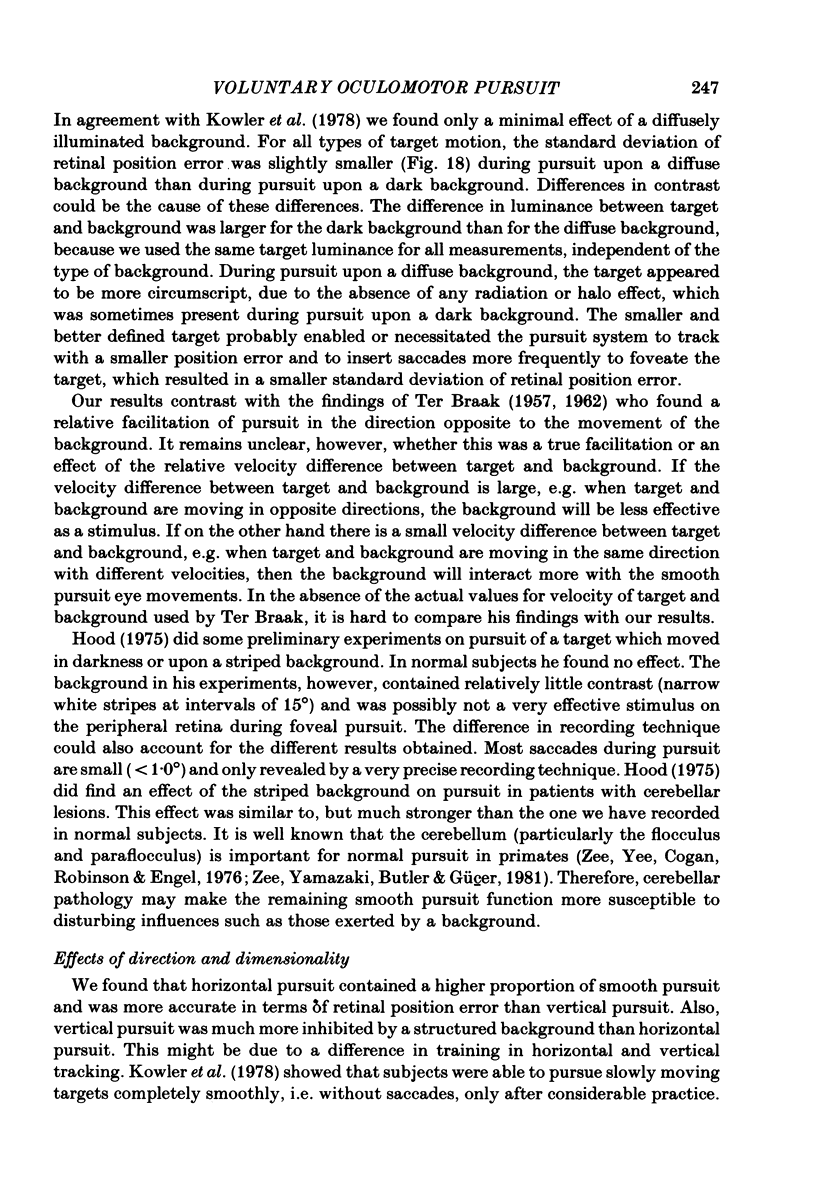
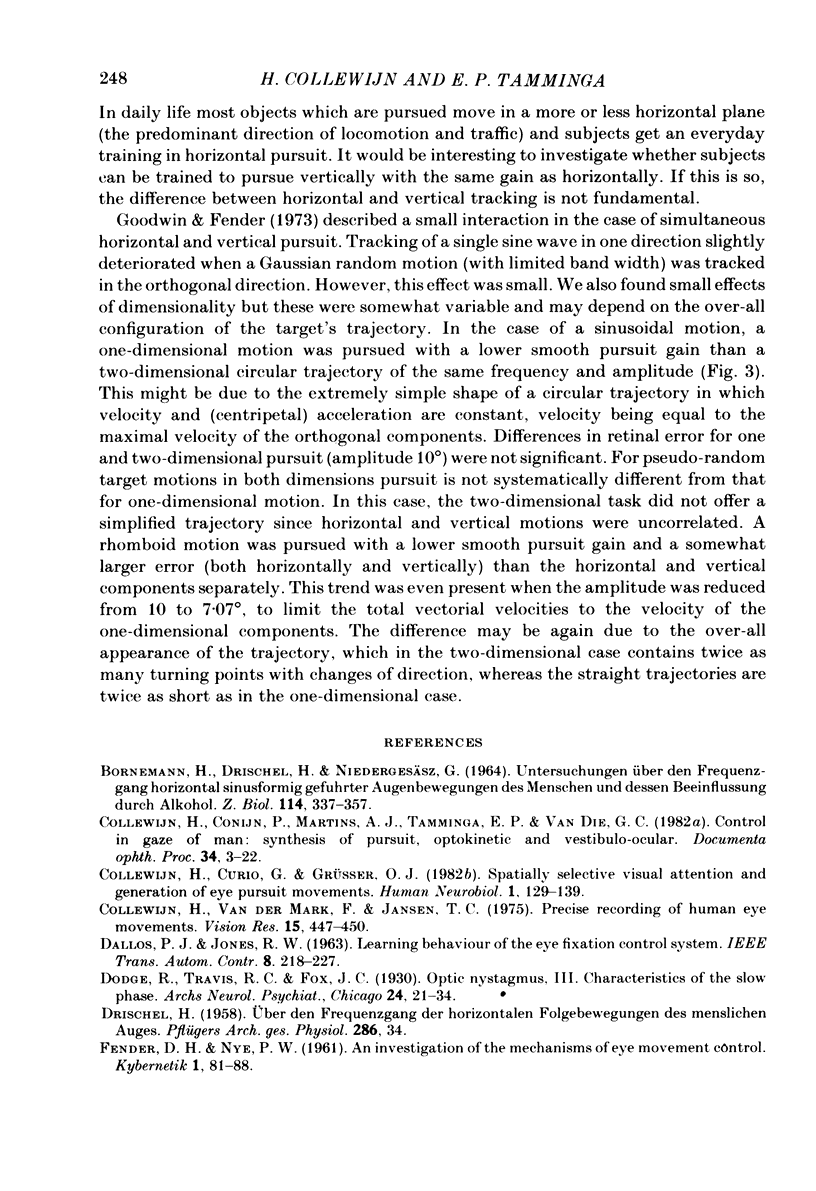
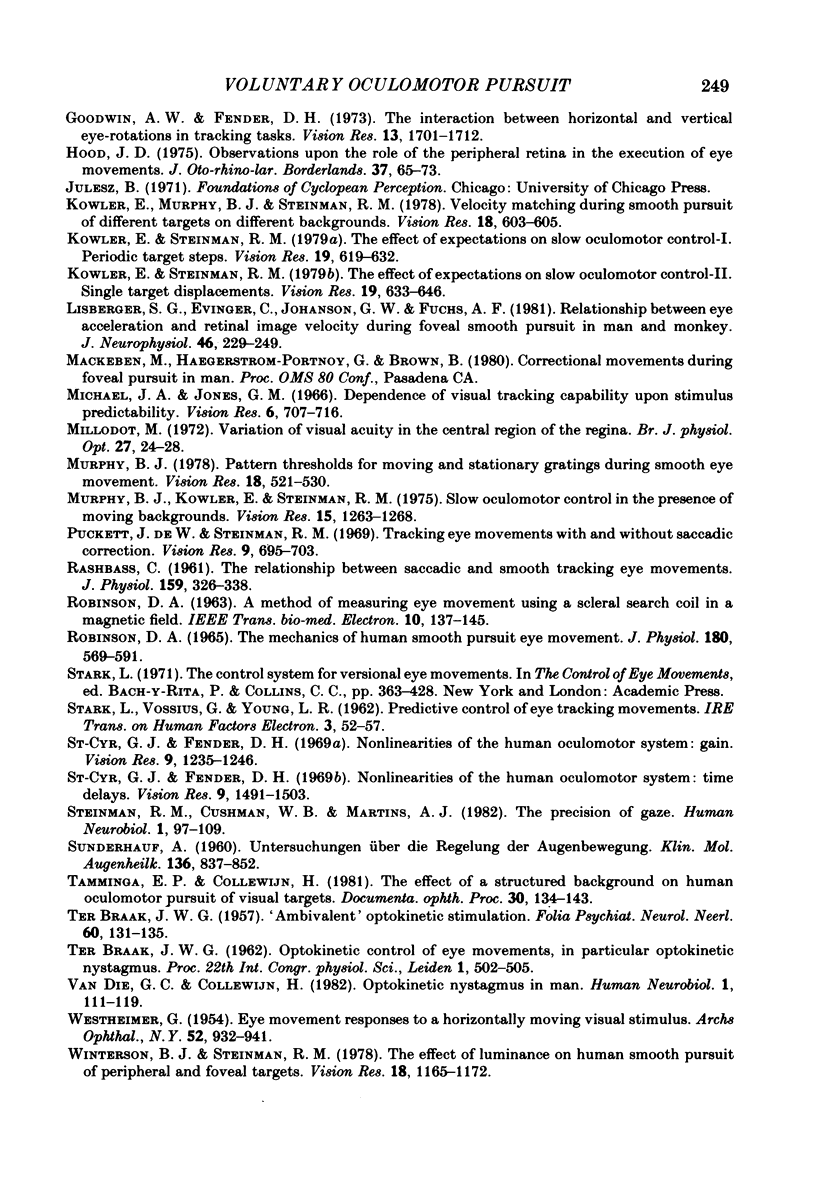
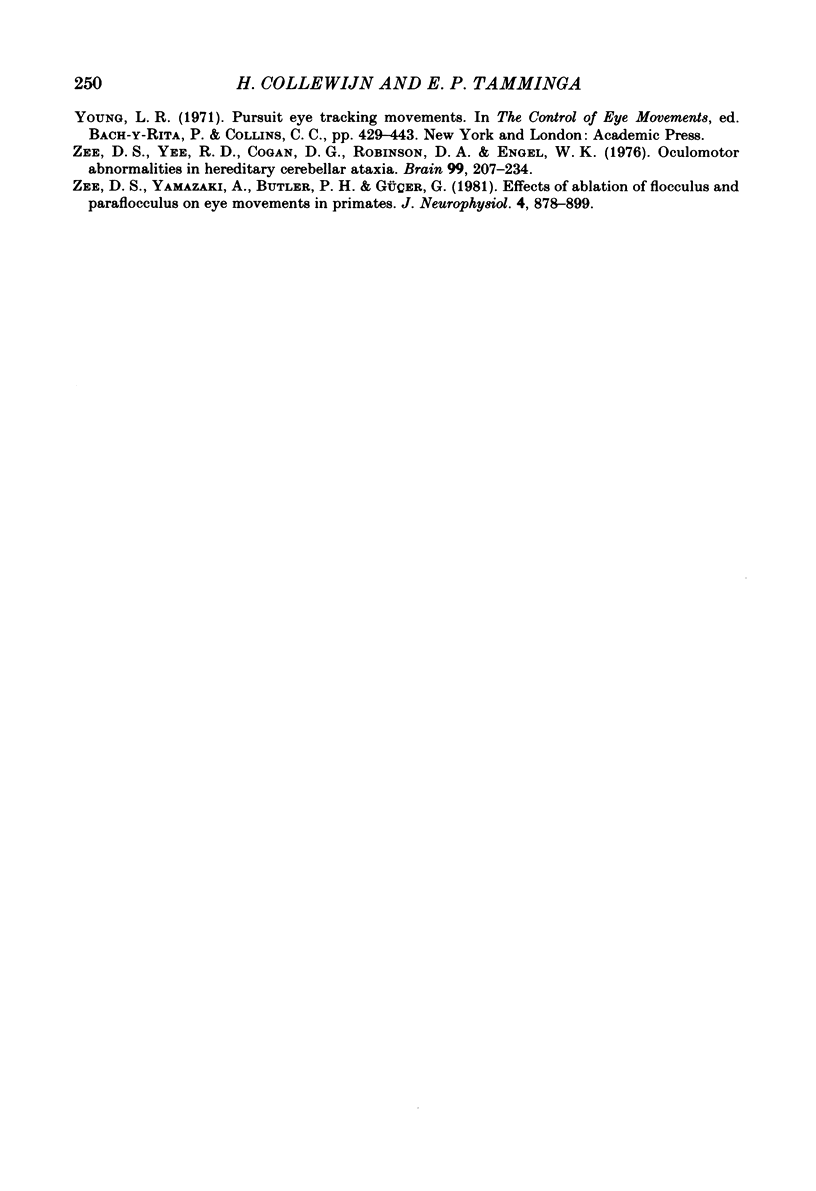
Selected References
These references are in PubMed. This may not be the complete list of references from this article.
- BORNEMANN H., DRISCHEL H., NIEDERGESAESS G. UNTERSUCHUNGEN UEBER DEN FREQUENZGANG HORIZONTAL SINUSFOERMIG GEFUEHRTER AUGENBEWEGUNGEN DES MENSCHEN UND DESSEN BEEINFLUSSUNG DURCH ALKOHOL. Z Biol. 1964 Jul;114:337–357. [PubMed] [Google Scholar]
- Collewijn H., Curio G., Grüsser O. J. Spatially selective visual attention and generation of eye pursuit movements. Experiments with sigma-movement. Hum Neurobiol. 1982;1(2):129–139. [PubMed] [Google Scholar]
- Collewijn H., van der Mark F., Jansen T. C. Precise recording of human eye movements. Vision Res. 1975 Mar;15(3):447–450. doi: 10.1016/0042-6989(75)90098-x. [DOI] [PubMed] [Google Scholar]
- FENDER D. H., NYE P. W. An investigation of the mechanisms of eye movement control. Kybernetik. 1961 Jul;1:81–88. doi: 10.1007/BF00288819. [DOI] [PubMed] [Google Scholar]
- Goodwin A. W., Fender D. H. The interaction between horizontal and vertical eye-rotations in tracking tasks. Vision Res. 1973 Sep;13(9):1701–1712. doi: 10.1016/0042-6989(73)90089-8. [DOI] [PubMed] [Google Scholar]
- Hood J. D. Observations upon the role of the peripheral retina in the execution of eye movements. ORL J Otorhinolaryngol Relat Spec. 1975;37(2):65–73. doi: 10.1159/000275208. [DOI] [PubMed] [Google Scholar]
- Knowler E., Murphy B. J., Steinman R. M. Velocity matching during smooth pursuit of different targets on different backgrounds. Vision Res. 1978;18(5):603–605. doi: 10.1016/0042-6989(78)90211-0. [DOI] [PubMed] [Google Scholar]
- Kowler E., Steinman R. M. The effect of expectations on slow oculomotor control. I. Periodic target steps. Vision Res. 1979;19(6):619–632. doi: 10.1016/0042-6989(79)90238-4. [DOI] [PubMed] [Google Scholar]
- Kowler E., Steinman R. M. The effect of expectations on slow oculomotor control. II. Single target displacements. Vision Res. 1979;19(6):633–646. doi: 10.1016/0042-6989(79)90239-6. [DOI] [PubMed] [Google Scholar]
- Lisberger S. G., Evinger C., Johanson G. W., Fuchs A. F. Relationship between eye acceleration and retinal image velocity during foveal smooth pursuit in man and monkey. J Neurophysiol. 1981 Aug;46(2):229–249. doi: 10.1152/jn.1981.46.2.229. [DOI] [PubMed] [Google Scholar]
- Michael J. A., Jones G. M. Dependence of visual tracking capability upon stimulus predictability. Vision Res. 1966 Dec;6(12):707–716. doi: 10.1016/0042-6989(66)90082-4. [DOI] [PubMed] [Google Scholar]
- Millodot M. Variation of visual acuity in the central region of the retina. Br J Physiol Opt. 1972;27(1):24–28. [PubMed] [Google Scholar]
- Murphy B. J., Kowler E., Steinman R. M. Slow oculomotor control in the presence of moving backgrounds. Vision Res. 1975 Nov;15(11):1263–1268. doi: 10.1016/0042-6989(75)90172-8. [DOI] [PubMed] [Google Scholar]
- Murphy B. J. Pattern thresholds for moving and stationary gratings during smooth eye movement. Vision Res. 1978;18(5):521–530. doi: 10.1016/0042-6989(78)90196-7. [DOI] [PubMed] [Google Scholar]
- Puckett J. D., Steinman R. M. Tracking eye movements with and without saccadic correction. Vision Res. 1969 Jun;9(6):695–703. doi: 10.1016/0042-6989(69)90126-6. [DOI] [PubMed] [Google Scholar]
- RASHBASS C. The relationship between saccadic and smooth tracking eye movements. J Physiol. 1961 Dec;159:326–338. doi: 10.1113/jphysiol.1961.sp006811. [DOI] [PMC free article] [PubMed] [Google Scholar]
- ROBINSON D. A. A METHOD OF MEASURING EYE MOVEMENT USING A SCLERAL SEARCH COIL IN A MAGNETIC FIELD. IEEE Trans Biomed Eng. 1963 Oct;10:137–145. doi: 10.1109/tbmel.1963.4322822. [DOI] [PubMed] [Google Scholar]
- Robinson D. A. The mechanics of human smooth pursuit eye movement. J Physiol. 1965 Oct;180(3):569–591. doi: 10.1113/jphysiol.1965.sp007718. [DOI] [PMC free article] [PubMed] [Google Scholar]
- St-Cyr G. J., Fender D. H. Nonlinearities of the human oculomotor system: gain. Vision Res. 1969 Oct;9(10):1235–1246. doi: 10.1016/0042-6989(69)90111-4. [DOI] [PubMed] [Google Scholar]
- St-Cyr G. J., Fender D. H. Nonlinearities of the human oculomotor system: time delays. Vision Res. 1969 Dec;9(12):1491–1503. doi: 10.1016/0042-6989(69)90065-0. [DOI] [PubMed] [Google Scholar]
- Steinman R. M., Cushman W. B., Martins A. J. The precision of gaze. A review. Hum Neurobiol. 1982;1(2):97–109. [PubMed] [Google Scholar]
- TER BRAAK J. Ambivalent optokinetic stimulation. Folia Psychiatr Neurol Neurochir Neerl. 1957 Apr;60(2):131–135. [PubMed] [Google Scholar]
- WESTHEIMER G. Eye movement responses to a horizontally moving visual stimulus. AMA Arch Ophthalmol. 1954 Dec;52(6):932–941. doi: 10.1001/archopht.1954.00920050938013. [DOI] [PubMed] [Google Scholar]
- Winterson B. J., Steinman R. M. The effect of luminance on human smooth pursuit of perifoveal and foveal targets. Vision Res. 1978;18(9):1165–1172. doi: 10.1016/0042-6989(78)90100-1. [DOI] [PubMed] [Google Scholar]
- Zee D. S., Yamazaki A., Butler P. H., Gücer G. Effects of ablation of flocculus and paraflocculus of eye movements in primate. J Neurophysiol. 1981 Oct;46(4):878–899. doi: 10.1152/jn.1981.46.4.878. [DOI] [PubMed] [Google Scholar]
- Zee D. S., Yee R. D., Cogan D. G., Robinson D. A., Engel W. K. Ocular motor abnormalities in hereditary cerebellar ataxia. Brain. 1976 Jun;99(2):207–234. doi: 10.1093/brain/99.2.207. [DOI] [PubMed] [Google Scholar]
- van Die G., Collewijn H. Optokinetic nystagmus in man. Role of central and peripheral retina and occurrence of asymmetries. Hum Neurobiol. 1982;1(2):111–119. [PubMed] [Google Scholar]


